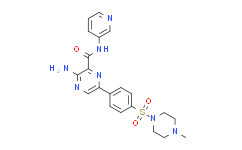| Cas No.: | 486424-20-8 |
| Chemical Name: | AZD-2858 |
| Synonyms: | AZD2858;3-amino-6-[4-(4-methylpiperazin-1-yl)sulfonylphenyl]-N-pyridin-3-ylpyrazine-2-carboxamide;3-Amino-6-{4-[(4-methyl-1-piperazinyl)sulfonyl]phenyl}-N-(3-pyrid inyl)-2-pyrazinecarboxamide;AZD 2858;AZD-2858;AZD 2858;3-amino-6-(4-((4-methylpiperazin-1-yl)sulfonyl)phenyl)-N-(pyridin-3-yl)pyrazine-2-carboxamide;3-Amino-6-{4-[(4-Methylpiperazin-1-Yl)sulfonyl]phenyl}-N-Pyridin-3-Ylpyrazine-2-Carboxamide;GSK-3 inhibition;3-amino-6-{4-[(4-methylpiperazin-1-yl)sulfonyl]phenyl}-N-(pyridin-3-yl)pyrazine-2-carboxamide;GTPL8478;C21H23N7O3S;AOB6850;FHCSBLWRG |
| SMILES: | S(C1C([H])=C([H])C(C2=C([H])N=C(C(C(N([H])C3=C([H])N=C([H])C([H])=C3[H])=O)=N2)N([H])[H])=C([H])C=1[H])(N1C([H])([H])C([H])([H])N(C([H])([H])[H])C([H])([H])C1([H])[H])(=O)=O |
| Formula: | C21H23N7O3S |
| M.Wt: | 453.52 |
| Sotrage: | 2 years -20°C powder, 2 weeks 4°C in DMSO, 6 months -80°C in DMSO |
| Description: | AZD2858 is a potent, orally active GSK-3 inhibitor, with IC50s of 0.9 and 5 nM for GSK-3α and GSK-3β, respectively, used in the research of fracture healing. |
| In Vivo: | AZD2858 (20 mg/kg) causes a dose-dependent increase in trabecular bone mass compared to control after a two-week treatment with a maximum effect[1]. AZD2858 exhibits a substantial effect on fracture healing. AZD2858 (20 mg/kg) causes an increase in cortical BMC of 9%, cortical area of 10%, and cortical thickness of 11% at 3 weeks in the non-operated right femur of rats[2]. AZD2858 (30 μmol/kg/day) alters the biomarkers of bone turnover with statistically significant increases in P1NP and decreases in TRAcP-5b seen from 3 days of treatment and onwards. AZD2858 demonstrates significant changes in serum bone turnover markers (P1NP and TRAcP-5b) and femur bone formation after only 7 days of daily dosing[3]. AZD2858 (AR28, 30 mg/kg, s.c.) stimulates an increase in an initial wave of mesenchymal progenitors with osteogenic and adipogenic potential and drives their differentiation to the osteogenic lineage in BALB/c mice. AR28 (30 mg/kg, s.c.) enhances the proliferation of committed hematopoietic progenitors and their differentiation to the osteoclast lineage but does not prevent an overall increase in bone mass[4]. |
| In Vitro: | AZD2858 (1 μM) increases β-catenin levels after a short period of time in human osteoblast cells. AZD2858 inhibits GSK-3β dependent phosphorylation with an IC50 of 68 nM. AZD2858 (10 nM) has no effect on β-catenin levels[1]. AZD2858 increases TAZ expression and osterix expression both by 1.4-fold, with EC50 of 440 nM and 1.2 μM, respectively, in hADSC. AZD2858 also induces a marked increase in osteogenic mineralisation in hADSC[3]. AZD2858 (AR28) demonstrates from 70- to greater than 6000-fold selectivity over a panel of other kinases and an IC50 of 5 nM. AR28 inhibits GSK-3 in murine cells and indicates activation of the canonical Wnt/β-catenin signaling cascade. AR28 (50, 10, and 1 nM) enhances the clonogenic ability of mesenchymal progenitors with osteogenic and adipogenic potential. AR28 (50 µM) also enhances the differentiation ability of mesenchymal progenitors to the osteogenic but not adipogenic lineage in vitro[4]. |

 To enhance service speed and avoid tariff delays, we've opened a US warehouse. All US orders ship directly from our US facility.
To enhance service speed and avoid tariff delays, we've opened a US warehouse. All US orders ship directly from our US facility.




















